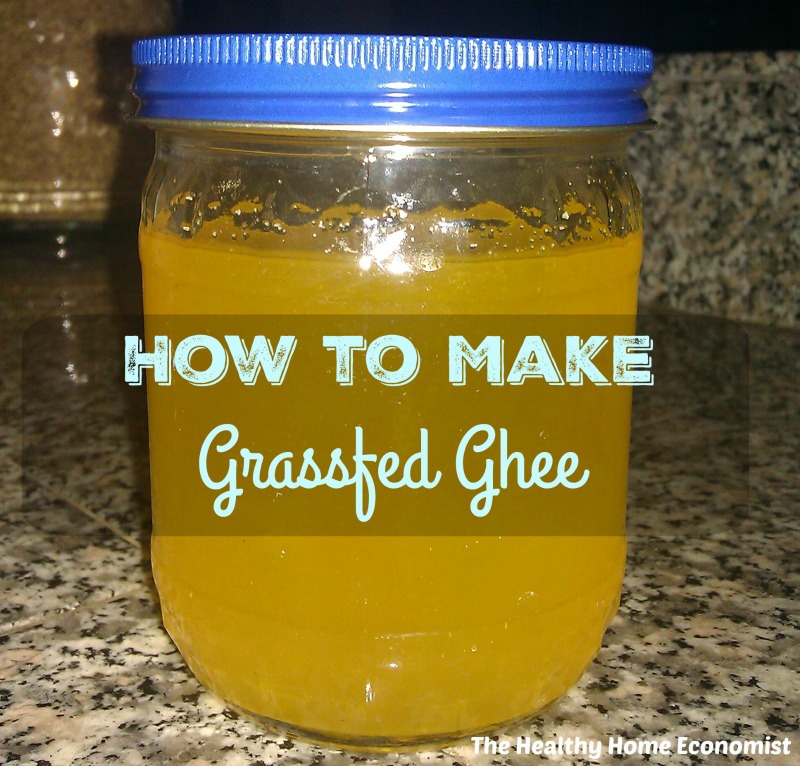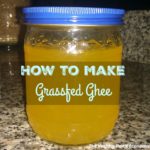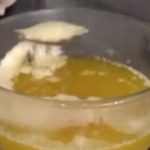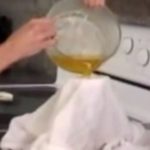Table of Contents[Hide][Show]
How to make homemade ghee on the stovetop quickly and easily for a healthy cooking fat that is shelf stable and nourishing.

Knowing how to make ghee is simply a must for any Traditional Cook. Clarified butter as it is also known, has been used for thousands of years by Indian cultures. In fact, traces of ghee have been found on fragments of Indian pottery dating as far back as 6500 BC!
When in a liquid state and made from unheated butter, ghee is called butter oil. Dr. Weston A. Price discovered that butter oil and cod liver oil work synergistically to supercharge absorption of Vitamins A, D, and K2 known as the X-factor.
Dr. Price always carried flasks of cod liver oil and butter oil to the bedside of very ill patients. More often than not, he was able to revive them with a few drops of each under the tongue. Using cod liver oil or butter oil separately did not have the same deathbed reviving effects.
Benefits of Ghee over Other Cooking Fats
It is best to know how to make clarified butter oil or ghee yourself rather than buying from the store. Notice the picture above of a jar that I made myself with pastured butter from a local farm. It is so yellow!
Commercial ghee from the store is a pale yellow, indicating lower nutritional value from cows eating grain mix instead of fresh green grass.
Ghee from the store is also ridiculously expensive, so learning to make it yourself is not only a more nutritious way to go, it is very cost-effective.
I make clarified butter oil for about half the cost of what it would be to buy it at the health food store.
Unlike butter, ghee does not need refrigeration and keeps well on the counter or pantry for many months. Keeping a jar in the pantry for a quick veggie saute is very convenient!
Another benefit of ghee is that it is easier to digest as all the milk solids (proteins) have been removed from the butter. Very frequently, even those with a true dairy allergy find that ghee presents no trouble for them.
Another advantage to using clarified butter instead of plain grass-fed butter is that the grassy taste and sometimes cheesy smell of the butter is eliminated.
Therefore, by learning to make clarified butter oil from grass-fed butter, you will find that you now have a healthy fat for cooking that does not displease your family with a cheesy odor. This can sometimes happen with grass-fed butter alone.
Homemade Grass-Fed Ghee
The recipe and video lesson below covers how to make this healthy and indispensable fat for use in your own kitchen.
I also cover how to make clarified butter capsules. This is a convenient way to take butter oil with your daily dose of cod liver oil.
If you are spending money on high vitamin cod liver oil (this is the brand I’ve used since 2015) it is a must to be taking it with clarified butter oil. This supercharges the beneficial effects!
Note that it is not advisable to make ghee from homemade raw butter. The heating process causes a loss of the enzyme and probiotics in this special food.
Prefer to Buy?
If after reviewing the recipe and video demo below you decide to buy instead, I would recommend this vetted source as a premier retailer of quality grass-fed ghee. Plain, cultured, and herb-flavored varieties are all available including a coconut oil/ghee blend.

How to Make Ghee
This simple recipe for making ghee can be accomplished on the stovetop in just a few minutes.
Ingredients
- 1 lb butter preferably grassfed and organic
- 1 wide mouthed mason jar quart size
- 1 cheesecloth fine mesh
- 1 funnel
Instructions
-
Place pound of butter in a medium sized pot or stove safe glass bowl. Turn heat on low and allow the butter to gently liquefy.
-
Turn heat to medium-low and gently remove foam that comes to the top of the melted butter with a slotted spoon.

-
After removing the foam, allow the melted butter to simmer on medium-low heat for 5-10 minutes longer to allow all the milk solids to settle out on the bottom of the bowl. You will know when the separation process is complete as the solids will be slightly brown on the bottom and the clarified butter will be completely clear and transparent.

-
Line a funnel placed into the open end of a wide mouthed mason jar with a fine mesh cheesecloth.
-
Pour the clarified butter into the funnel so that it is strained through the cheesecloth as it enters the mason jar.

-
Allow the finished ghee to cool in the mason jar. When room temperature, fasten the lid on tightly and store in the pantry as a convenient and incredibly healthy cooking oil for all your kitchen needs.








Hi Sarah. I have made ghee for years and have simplified the process to eliminate the chance of burning the ghee or having butter boiling or popping in the pot and making a mess. This modification takes longer in total time but is worth it in my experience!
Follow the steps for gently melting the butter over low heat and removing the solids that rise to the top in the video.
I then refrigerate the melted butter until solid (usually 3-5 hours or overnight)
Once solid, take a knife and cut out a wedge in the solid butter and drain the excess water that is underneath the re-solidified butter. Once water is mostly gone, place the pot on the stovetop and melt again at low temp till the milk solids settle on the bottom and turn a light brown, as described in the video. Follow the cheesecloth filtration etc from Sarah.
Hi Sarah,
I have 9 year old son, just found out he has cavities, as he does not like sugary stuff. So it makes me wonder why he has cavities? I was reading your article how you cured your son’s cavity with Cod liver oil and Butter oil capsules. My question is the same as other mom, I was just curious, did you make your own butter oil capsules when you were dealing with your son’s cavity? Or did you buy the butter oil that is extracted without heat? – What will be the dose for butter oil if I make it at home. Will the raw butter will be as effective as butter oil. Please let me know.
Thanks,
Sukhi.
Hi Sarah,
I have the same question as Kezia above…did you use butter oil that you made or from Green pastures while your child’s cavity healed? Also are you familiar with grass fed butter named Kerry Gold? If so, do you think good to make ghee with? Thank you for your time and all that you do!
I was reading your article this morning about how you cured your son’s cavity with Cod liver oil and Butter oil capsules. I am trying desperately to cure my cavities naturally so that I don’t have to go back to the dentist! I was just curious, did you make your own butter oil capsules when you were dealing with your son’s cavity? Or did you buy the butter oil that is extracted without heat?
Thank you for your video on making ghee! I was wondering about the amounts of the ghee and the fermented cod oil to give my 4-year old ? He definitely would not take a capsule -thanks so much!!
Thanks Sarah for the wonderful video. I tried making ghee for the first time today but think I may have cooked it too long. It is not clear but a bit cloudy and the color is more like light amber honey than golden yellow. Should you be able to see through the ghee after it’s been strained into the jar? And if it is overcooked, is it still good to consume or should I start over when I buy my next container of raw butter? Thanks for any advice!
Since I buy organic grass fed raw milk and their raw butter from Organic Pastures, which is very expensive ($15 a gallon for the milk), I am not willing to heat these raw products to make either ghee or for any other reason since it kind of” takes the raw out of raw”. I would rather use a good grass fed organic butter to make ghee so will most likely use Kerrygold, although there is now some issue with them being bought out and claims that Kerrygold has been found to not be as organic and grass fed as thought. There are some other options for organic butter, but the real issue that we are all dealing with, with limited incomes, is that eating paleo and grass fed organic “everything” can be extremely expensive.
I was using Green Pastures fermented cod liver oil and butter, unflavored and loved it, didn’t even mind the taste. But with the expense of $50 a month, I had to prioritize and decide which things I could substitute so I could keep up my raw milk addiction.
So the real issue for me is that heating raw milk and raw butter makes it no longer raw. When I need to heat milk I use another high quality grass fed pasteurized milk. I have had a weight issue and raw milk was one of the few things that I could eat to get enough calories to keep my weight up, so it is not something I want to give up and being raw, I feel much better about it being a good source of nutrition for me.
So I guess my question would be does it really make a difference in making ghee with raw grass fed milk vs another pasteurized grass fed organic milk. Also I now take Nordic Naturals Arctic Cod with my ghee, which has been a more cost effective way of getting, I hope, similar benefits as taking Green Pastures fermented oil and butter. I wish I could afford all the great supplements and foods out there but we all have a budget and have to make choices that best meet those budgets. Best Wishes to all for a Happy, Healthy 2014.
Sounds great and effective. But what do you do if your vegetarian. I have no problem eating ghee. I don’t want to eat fish and I wonder if there is something else that could replace the cod liver oil ?
merci !
Unfortunately, the only substitute for fermented cod liver oil would be eating actual liver a couple times a week. There is no plant based substitute.
Hi Sarah,
I tried making ghee with the pound of butter I had on hand (not grass-fed, just regular store-bought), as a trial run. It didn’t come out the way you show us in your video — please tell me what I did wrong.
I had to turn the heat way down to the lowest setting once the butter melted. Otherwise the liquid butter would pop and jump and make a mess all around. But that way I did not get that much foam on the surface as in your video — I had to keep skimming off the little bit that comes up on top. I eventually had the pan on the heat for 1.5 hours, but it never got so clear that I could see right through to the bottom. And the milk solids did not quite separate. Well, it did sort of coagulate, but… I started with one pound of butter, but at the end I only got 11 oz. because of the still quite liquidy milk solids.
Where do you see the problem? I need your help. Both my son and I have issues with out teeth. Thank you!!!
Hi , I hope you didn’t already answer this. There were too many posts to read all. What is that great glass bowl you used on the stove to boil the ghee?